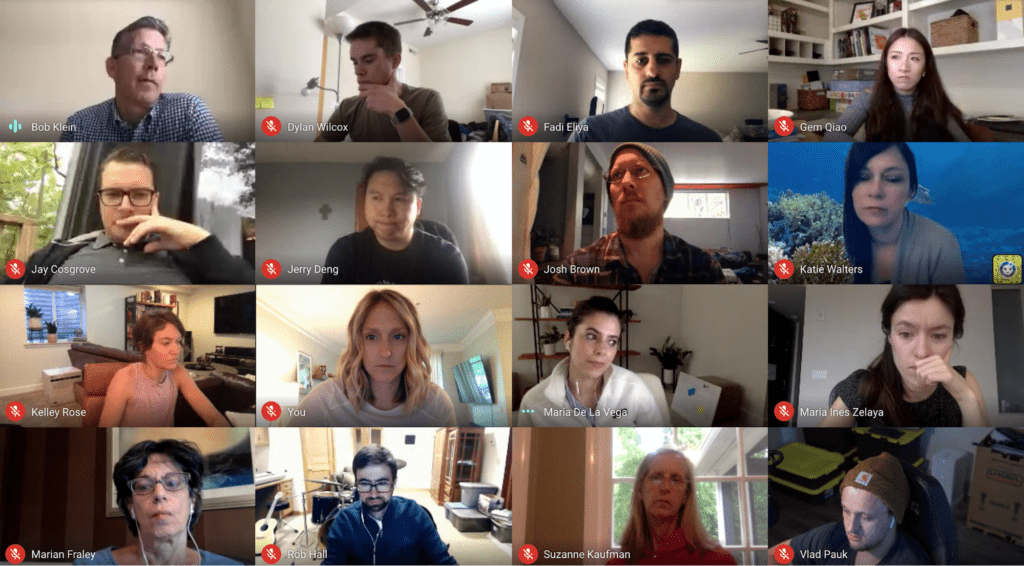Well, it’s been a crazy ride since our rebranding. It’s hard to find an upside to living under the weight of a pandemic, but one silver lining is the country’s growing dependence on digital technology, which has kept us very busy here at DS.
The biggest shift we’re seeing in the digital landscape is people’s increasing reliance on video conferencing. Like most innovation labs, we’re accustomed to collaborating together in the same space as we run our clients through discovery workshops and design sprints. But over the years, as we’ve expanded our client base from regional to national, we’ve also adopted remote processes to better collaborate with clients across the country. While the pandemic has forced many businesses to adjust their business models overnight, we’ve been able to make a seamless transition to being fully remote thanks to the tools and processes we’ve set up and fine-tuned over the years.
Coronavirus: How COVID-19 is changing the way we work
One of the most common questions our clients ask us is How can I smoothly transition my team to remote work? Aside from the standard responses provided by HR teams across the country, we asked our teams of designers and developers how they make remote work a success. Here are a few tips they’ve offered.
Don’t waste this time
Five ways to engage your team during quarantine
1. Invest in your people
These days, it’s easy for some of your team to feel sluggish and unmotivated. We’re going through a crisis after all. But as a leader, now is the time to encourage your team to learn new things. Due to our current state, many conferences and online learning platforms that were once very costly are now open to the public for discounted prices, or even at no charge.
For example, our product team attended the free TSW Live, and our design team has been hard at work refining their skills by participating in Remote Design Week. They also plan on attending the Adobe 99U Conference in June. Check out conferences in your industry and see what’s out there. Linkedin Learning is now offering a full month free. If you’ve been putting off sending your team to a specific training, see if there is a remote offering. These small investments in your team members can help them feel valued.
To further stretch your teams’ skills and thinking, you can also suggest reading a book together. Each of our teams reads books that will help them think outside the box. Currently, our product team has been reading Nir Eyal’s Indistractible.
2. Video matters
One of the unofficial rules we set for ourselves from the get-go was to use our webcams whenever possible. We find that the ability to see our faces during stand-ups, meetings, and general team check-ins makes a huge impact. It makes the connection more personal, keeps everyone engaged, and helps team members virtually read the room. And let’s face it – it’s just nice to be able to see everyone you are talking with.

3. Intentional time to unwind
It may seem counterintuitive, but to keep productivity high, we have intentionally created downtime to connect and decompress.
One way we do this is through our new #mindfulness channel on Slack. Once or twice a week, we set aside 20 minutes to practice meditation breathing exercises and stretches that are created specifically to help each of us relax and connect.
If you’re more of a Ron Swanson type, and not really into mindfulness, you could also join our team for biweekly “Lunch and Board Games” where the team can get their competitive juices flowing. Some good ol’ tomfoolery might be just what your team needs during this time.

4. Trust your team to control their hours
Whether some of your team members are struggling with loneliness, others may be juggling kids, spouses, dogs, or neighbors. One of the best things you can do during this time is to provide flexibility.
Here at DS, we have a six-hour window where we ask everyone to work. This window of time is 10 am to 4 pm. During this time, we schedule necessary meetings and know that others will respond to our Slack messages as soon as they can.
As for me, I am simultaneously working and running a daycare, albeit a very bad one, with my three children who are five years old and younger. The ability to start working around 7 am and end my work day at 4 pm (when they inevitably become stir-crazy animals that need to be released into the wild) has made my life manageable in an otherwise crazy situation. The same goes for those who may be struggling in other ways. Their social hours may be used for talking or gaming with friends during the late-night hours, but they have freedom in knowing they can sleep in until 9:55…when they can immediately jump out of bed and get right to work.
The point is that our flexibility at DS, which has been around long before this crisis hit, allows for people to choose the best hours that work for them.

5. Invest in your team’s next steps
One of the biggest mistakes that leaders can make during this time is to stop innovating and planning for your future. Yes, the world seems to be frozen in time, but trust us when we say your competitors are not standing in place. Due to the economic reality, planning for your company’s future is more important than ever. This is a great time to get out of your rut, and get your idea created and tested with a remote Design Sprint.
Developed by Google Ventures, a Design Sprint is an intensive four- to five-day process that aligns your team around big challenges to create a new product or improve existing ones. This hands-on experience ends with the testing and validation of your concept with real users.
From there, we will help take your validated idea to market. Fast.
Want to learn more? Contact us today and let’s begin the conversation.


